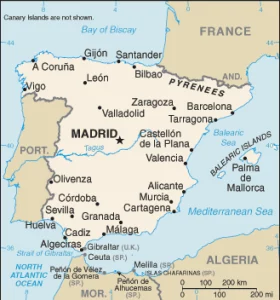Importing from Spain


Spain Country Profile
Official Name (Local Language) Reino de Espana
Capital Madrid
Population 48,563,476
Currency Euro
GDP $1,252 billion
Languages Spanish
Telephone Dial In 34
Spain Exports Profile
Exports ($m USD) 319,622
Number of Export Products 4,491
Number of Export Partners 228

Spain Economic Statistics
Government Website | https://www.lamoncloa.gob.es/ |
| Sovereign Ratings | https://countryeconomy.com/ratings/spain |
| Central Bank | Banco de España |
| Currency USD Exchange Rate | 0.9214 |
| Unemployment Rate | 19.7% |
| Population below poverty line | 21.1% |
| Inflation Rate | -0.3% |
| Prime Lending Rate | 0.05% |
| GDP | $1,252 billion |
| GDP Pro Capita (PPP) | $36,500 |
| Currency Name | Euro |
| Currency Code | EUR |
| World Bank Classification | High Income |
| Competitive Industrial Performance | 32/138 |
| Corruption Perceptions Index | 42/180 |
| Ease of Doing Business | 30/190 |
| Enabling Trade Index | 15/136 |
Access trade, receivables and supply chain finance
We assist companies to access trade and receivables finance through our relationships with 270+ banks, funds and alternative finance houses.
Get StartedImporting from Spain
Spain is a highly agriculturally focused country and produces large crops of barley, wheat, tomatoes, olives, lemons and many other fruits and vegetables. These helped push exports to $318.6 billion in 2014, up 29.4% from 2010.
Spain achieved a trade surplus for the first time in three decades in 2013 following a policy of reducing imports and increasing exports, while in 2015 the GDP grew by 3.2%, a rate not seen since the crisis struck in 2008. Top Spanish exports are vehicles (16.2%), machines (7.6%) and oil (7.2%).
Importing from Spain: What is trade finance?
Trade finance is a revolving facility which alternative lenders offer – it enables firms to buy inventory and can help ease working capital problems.
Often, a trade financier will fund most of the cost of the stock, including charges (e.g. delivery costs).
Trade finance offers benefits over more traditional bank funding, for example, bridging mortgages or loans. Trade finance provides up front funding without affecting existing relationships with banks.
How does it work?
If you’re a firm importing or exporting products outside of your own country, then a trade finance facility would assist your company to fund this through offering a letter of credit or some form of cash advance.
I’m looking to import from Spain, how can Trade Finance Global help, and how does it work?
If you are looking to import products from other countries, you may require import finance, which is an agreement between yourself (the importer) and the foreign exporter. A alternative financier will act as the intermediary, paying the exporter on your behalf until you receive the stock and have then sold them to your buyer. Repaying the financier then occurs over an agreed period.
Chart Showing GDP Growth Compared to rest of world
GDP Composition for Spain
Agriculture
2.5%
Grain, vegetables, olives, wine grapes, sugar beets, citrus; beef, pork, poultry, dairy products; fish
Industry
22.4%
Textiles and apparel (including footwear), food and beverages, metals and metal manufactures, chemicals, shipbuilding, automobiles, machine tools, tourism, clay and refractory products, footwear, pharmaceuticals, medical equipment
Services
75.1%
Map
Top 5 Exports Partners
| Country | Trade | % Partner Share |
| France | 46,955 | 14.69 |
| Germany | 34,899 | 10.92 |
| Italy | 25,084 | 7.85 |
| Portugal | 22,379 | 7.00 |
| United Kingdom | 21,371 | 6.69 |
Top 5 Exports Products
| Export Product | Number |
| Petroleum oils, etc, (excl. crude); preparation | 11.2% |
| Automobiles with diesel engine displacing more | 4.0% |
| Automobiles with reciprocating piston engine di | 3.4% |
| Other medicaments of mixed or unmixed products, | 2.4% |
| Automobiles with diesel engine displacing not m | 1.9% |
Local Authors
Local Partners
- All Topics
- Spain Trade Resources
- Export Finance and ECA Topics
- Local Conferences




















